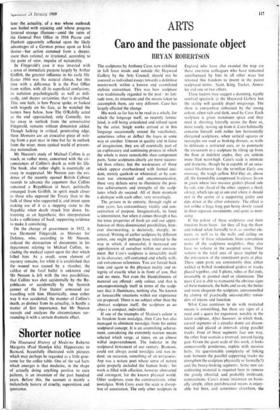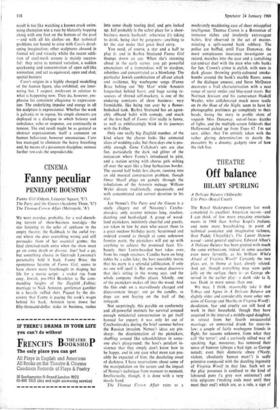Caro and the passionate object ARTS
BRYAN ROBERTSON
The sculptures by Anthony Caro, now exhibited in full force inside and outside the Hayward Gallery by the Arts Council, should not be assessed as individual essays towards a definitive masterwork within a known and assimilated stylistic convention. This was how sculpture was traditionally regarded in the past—its lati- tude now, its intentions and the means taken to accomplish them, are very different. Caro has largely erected the change -- His work so far has to be read as a whole, for which the language itself, so recently formu- lated, is still being articulated and refined upon by the artist. Single works arrived at in this language occasionally extend the vocabulary, sometimes refine or deflect the logos in some way or another. Uneven in quality and in force of imagination, they are all essentially part of an exploratory and continuing process in which the whole is more remarkable than component parts. Some sculptures clearly are more success- ful than others; but the weaknesses of those which appear overburdened with formal inci- dent, merely quirkish or whimsical, or by con- trast too attenuated and uncommunicative, these very defects serve to illuminate the posi- tive achievements and strengths of the sculp- tures which do succeed. All of them maintain a dialogue with each other, very revealingly.
The gesture in its entirety, through eight or nine years, has extraordinary vitality and con- centration of purpose. Imaginatively, its force is intermittent, but when it comes through it has the tonic properties of fresh air and our appre- hension of three-dimensional possibilities, how- ever disconcerting, is decisively, sharply; in- creased. Writing of earlier sculpture by different artists, one might perhaps have referred to the way in which, if successful, it increased our apprehension of ourselves within our environ- ment. But Caro's sculpture is intractably itself in its character, self-contained and wholly with- out extraneous references. You are forced back time and again to the physical reality and in- tegrity of exactly what is in front of you, that and no more. Not even the blandishments of material are offered: only colour, and that is uncompromisingly itself in terms of the sculp- ture that it illuminates, nothing else. No known or foreseeable situations within our experience are proposed. There is no subject other than the abstract sculpture itself; the sculpture as an object is compact, indivisible.
If one of the triumphs of Matisse's colour is its freedom from nostalgia, then Caro has also managed to eliminate nostalgia from his entire sculptural concept. It is an astonishing achieve- ment, considering the extremely narrow means selected which verge, at times, on an almost wilful impoverishment. The lodestar in the sculptural firmament of our century, Brancusi, could not always avoid nostalgia and was in- deed, on occasion, something of an antiquaire; Arp was a nature poet whose sense of nature quite properly included the human body: his work is filled with affection, however abstracted and astringent, for the known physical world. Other sculptors, even the constructivists, other nostalgias. With Caro, even the scale is disrup- tive of association. The only other sculptors in England who have also avoided the trap are ' those one-time colleagues who have remained uninfluenced by him in all other ways but retained this freedom to invent in the purest sculptural terms: Scott, King, Tucker, Annes- ley and one or two others.
These factors may suggest a daunting, rigidly cerebral spectacle at the Hayward Gallery but the reality will quickly dispel misgivings. The show is everywhere enlivened by the strong colour, often rich and dark, used by Caro. Each sculpture is given maximum space and they need it, shooting laterally across the floor or, more rarely, rearing up from it. Caro habitually concerns himself with rather low horizontally elongated sculptures; when vertical squares or rectangles are used as braking devices, as walls to delineate a restricted area, or to punctuate the movement in a sculpture by tilting up from the floor at indolent angles, they are seldom more than waist-high. Caro's scale is intimate and domestic, though he is capable of an occa- sional blockbuster like the vermilion Early one morning, the tough yellow Mid-Day or, above all, the formidably compressed Sculpture Seven in green where two massive girders placed side by side, one ahead of the other, support a third, on top, which tips up at one end where it should rest in the centre of a supporting girder and dips down at the other extremity. The effect is not unlike a huge long gun being slowly raised in three separate movements, and quite as men- acing.
If the colour of these sculptures and their freedom from bases —for they all hug the floor and indeed relate formally to it, as another ele- ment, as well as to the walls and ceiling on occasion—if these relaxations from convention make all the sculptures weightless, they also have no volume in the accepted sense. Their volume is the total area of space implied by the interaction of the constituent parts at play. These open parts are consistently thin, either welded or bolted standardised girders or tracks placed together, and T-plates, tubes or flat rods, invariably in painted steel or aluminium: The more Caro is able to transcend the obvious signs of these materials, the bolts and so on, the better and more eloquent the sculpture, untrammelled by clumsy (if practically unavoidable) remin- ders of means and function.
What Caro contrives to do with restricted means is astonishing, but there are signs of a need and a quest for expansion, notably in the latest sculpture, After Summer, in which thick, curved segments of a circular dome are discon- nected and placed at intervals along parallel tracks. Four of these segments face one way, the other four contain a reversed, inward-facing pair. Given the giant scale of this work, it looks unnecessarily ponderous, replete with massive bolts, the questionable complexity of linking rods between the parallel supporting tracks (to strengthen the sculpture physically or formally?) and the heavy-looking segments. Some new co- ordinating material is required here to remove the grimly eflortful, and probably irrelevant, connotations. Caro's ironic insistence on basic- ally simple, often prefabricated means is enjoy- able but here, and sometimes elsewhere, the
result is too like watching a known crack swim- ming champion win a race by blatantly hopping along with one foot on the bottom of the pool —and with all his clothes • on. But technical problems are bound to arise with Caro's devel- oping imagination; other sculptures abound in formal wit and vivacity whilst the recent addi- tion of steel-mesh screens is mainly success- ful: they serve as textural variation, a sudden quickening and concentration of open cell-like animation, and act as equivocal, open and shut, spatial barriers Caro's origins in a highly charged modelling of the human figure, also exhibited, are inter- esting but, I suspect, irrelevant in relation to what is happening now. They do, however, em- phasise his consistent allegiance to expression- ism. The underlying impulse and energy in all his sculpture is expressionist. Whether the work is galvanic or in repose, his simple elements are deployed in a dialogue in which balance and imbalance, echo or response, are continually in tension. The end result might be as gestural as abstract expressionism, itself a comment on human behaviour, however unconscious. Caro has managed to eliminate the heavy breathing and, by means of a passionate discipline, venture further towards the unpredictable.



































 Previous page
Previous page